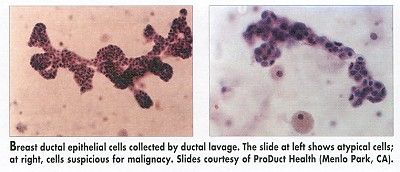Ductal Lavage Provides Early Detection of Atypical Cells
SAN ANTONIO-Ductal lavage, used to detect atypical and malignant cells in the milk ducts, may be a useful adjunct to mammography and other screening tools for women at high risk of developing breast cancer.
SAN ANTONIODuctal lavage, used to detect atypical and malignant cells in the milk ducts, may be a useful adjunct to mammography and other screening tools for women at high risk of developing breast cancer.
In a large, multicenter trial of 507 high-risk women with normal mammograms and physical exams, 383 were eligible to undergo ductal lavage. The procedure identified atypical cells in 17% of study participants and suspicious or malignant cells in 7%, William C. Dooley, MD, of Johns Hopkins University Breast Cancer Center, said at the 23rd Annual San Antonio Breast Cancer Symposium.
Atypical cells on cytology confer an increase in breast cancer risk similar to that of atypical hyperplasia on biopsy, he said.
Physicians have long known that nipple discharge is a potential sign of cancer. "Cytology of spontaneous nipple discharge has been performed for decades ," Dr. Dooley said. However nipple aspirate fluid produces "far fewer" cells available for examination than ductal lavage, he said.
Before ductal lavage begins, an anesthetic cream is applied to the nipple to numb the area. Next, a small suction cup is used to draw small amounts of ductal fluid up to the nipple surface. One or more of the ducts that produce fluid are selected for lavage. In this study, women who failed to produce nipple aspirate fluid were not candidates for ductal lavage.
To start the procedure, a microcatheter is inserted about one-half inch into the duct opening, Anesthetic is infused through the catheter to numb the inside of the duct. The anesthetic is followed by an infusion of 10 to 20 mL of sterile saline, which rinses the duct and collects cells from the ductal lining. This ductal fluid is withdrawn through the catheter and deposited into a collection vial, which is sent to a cytology lab for analysis.
Ductal lavage identifies changes in the epithelial cells that line the ducts and lobules of the breast, the region where cancer originates. In most cases, atypical cells do not progress to cancer, but finding atypical cells identifies women who are at higher risk of developing breast cancer.
Ductal lavage cannot be used as a screening tool for breast cancer because its sensitivity and specificity for identifying breast cancer are not known, Joyce O’Shaughnessy, MD, co-director of breast cancer research, Baylor-Sammons Cancer Center, Dallas, said at a press luncheon. The luncheon was sponsored by ProDuct Health (Menlo Park, California), makers of the breast aspirator and microcatheter used in the study.
When combined with a physical examination and imaging modalities, the information gained from ductal lavage can be used to help evaluate risk and assist patients in making decisions related to cancer prevention, such as closer monitoring and risk reduction through drug therapy or surgical intervention.
A patient’s cellular status can be monitored over time by retesting specific ducts at regular intervals.
To conduct the study, 507 women at risk for breast cancer were enrolled from 19 cancer centers. High-risk status was defined as having previous breast cancer, testing positive for a BRCA1 or BRCA2 mutation, or having a Gail index score of 1.7 or higher. Of the 507 women, 199 (39%) had a Gail risk of at least 1.7. The women had normal mammograms and physical exams within 12 months prior to study participation.
Of the 507 participants, 124 (24%) did not proceed to ductal lavage due to a failure to produce nipple aspirate fluid or lack of other eligibility factors. Lavage fluid was collected from 383 eligible women with an average yield of 40,000 cells per sample. Three cytopathologists at a central location reviewed the samples. Consensus among the cytopathologists reached 89%, Dr. Dooley said.
The analysis showed atypical cells in 17% of the study participants (66 women) and suspicious or malignant cells in 7% (26 women) (see Figure). Cells were benign in 54% (207 women), and inadequate for analysis in 22% (84 women).

Eleven women with suspicious or malignant lavage findings have undergone surgical exploration to date. Four cases of ductal carcinoma in situ (DCIS), five cases of multiple papilloma, and two cases of fibrocystic disease were found. Before surgery, these women had repeat mammography with unsuspicious findings. Long-term follow-up is needed to determine the sensitivity and specificity of ductal lavage, Dr. Dooley said.
Ductal lavage was "safe and well tolerated," he said. Two women had minor presumed infections that were treated and resolved with antibiotics. Dr. O’Shaughnessy noted that 82% of the women said the pain was less than or equal to that of their annual mammogram. She added that women who had breast-fed their babies described having no sensation with the insertion of the microcatheter.
Ductal lavage has a "steep learning curve," Dr. Dooley said. Various practitioners at the participating centers, including medical oncologists and nurse-practitioners, successfully learned to do ductal lavage. Surgeons attempted to aspirate the highest number of ducts and had the highest success rate (87%) in terms of obtaining a sample of nipple aspirate fluid.
Currently, ductal lavage is available only at select centers because physicians must receive training from ProDuct Health before they perform the procedure. A list of centers that offer ductal lavage and accept referral patients can be found at www.ductallavage.com.